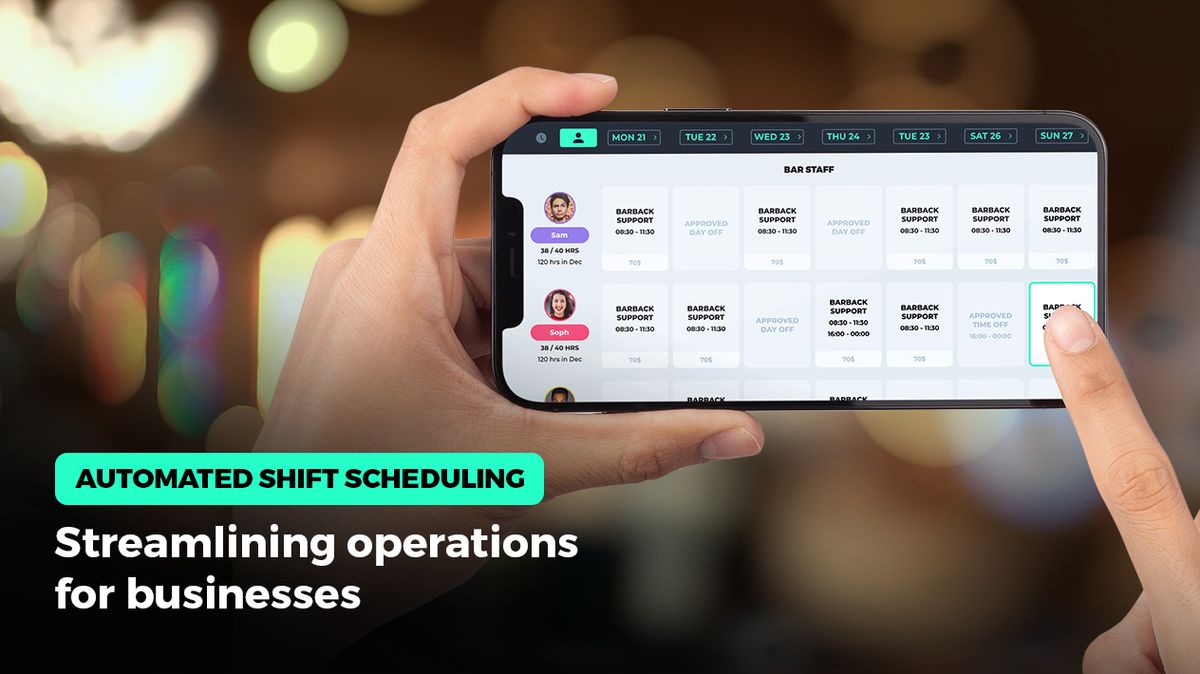Automated shift scheduling: Streamlining operations for businesses

We live in the digital age, and every day we encounter an abundance of new technologies that are frequently to our benefit. An instance of the above is scheduling software with multiple functions that positively impact businesses' organization and structure. So, digitally managing a business's processes can be a lifesaver for the organization and its future continuity.
These procedures were performed manually for many years, meaning the programs, tasks, shifts, and personnel distribution were all written by hand or in spreadsheets. Therefore, when the time came for a possible change in the program, the manual scheduling had to be reworked entirely, and the managers had to make many phone calls and send numerous messages to inform the employees of the potential modifications. This is how schedule conflicts appear.
Moreover, finding a replacement in a scheduling alteration is just as time-consuming and challenging. Therefore, a company with rotating or night shifts should adopt employee scheduling software to improve the team's organization and productivity.
Βelow we will discuss the impact that manual shift scheduling had on the business and how these disadvantages were now compensated with employee scheduling software. We will also examine the essence of automation in schedules, as well as the primary benefits that an individual can gain from utilizing the best shift scheduling software.
The Disadvantages of Manual Shift Scheduling
Manual shift scheduling can negatively affect the business's functionality and general flow. Specifically, it is a time-consuming process, but as previously mentioned, its greatest drawback is the extreme difficulty communicating the changes on it.
Given, for instance, that a shift was moved or the working hours were altered, it is possible that scheduling conflicts could arise because not everyone would be notified promptly. In addition, there is always the possibility of human error with manual shift scheduling, as it is possible that plenty of employees take over the shift, and the other shifts are without the necessary number of staff. Thus, we are once again faced with the complicated process of program modification.
Handling scheduling conflicts is one of the most important ways to maintain harmony among staff members and managers. The drawbacks above, especially the conflicts, generate a sense of discontent within the team.
Additionally, avoiding schedule conflicts can enhance customer service and overall operational effectiveness. The schedule and the observance of shifts are essential to the success of the business and its development over time. However, manual shift scheduling prevents the activities above from occurring.
What is automated shift scheduling software?
Ultimately, you need robust employee scheduling software for your business to deal with scheduling conflicts. With an automated shift scheduling app, the employee can plan his schedule, assign tasks, trade shifts, and achieve a work-life balance. Moreover, team members can easily swap shifts, and the manager can manage employee schedules, prevent conflicts, identify unavailable employees, and boost employee productivity.
The process of using software or computer systems to create and manage employee work schedules is known as automated shift scheduling, and it eliminates the need for manual scheduling techniques. Automated scheduling systems optimize the allocation of shifts based on employee availability, skill sets, labor costs, laws, and business requirements using algorithms.
Automated shift planning is crucial for all businesses with rolling hours, 24-hour staff, or night shifts, such as hospitals, restaurants, hotels, cafes, and call centers; generally, all companies require many employees outside the standard 9 to 5 workday.
Automated shift scheduling saves time compared to the previous schedule by streamlining the scheduling process, eliminating the need for managers to create schedules for hours manually.
Enhanced productivity and cost reductions are gained by matching staffing needs to demand, avoiding over- and understaffing. Moreover, optimized schedules have significant effects on labor costs, such as reducing overtime and improving payroll accuracy.
Numerous automated shift scheduling apps contain artificial intelligence and machine learning, enabling the applications to analyze existing data, trends, and other relevant factors to predict the demand for staffing at various times. Considering this demand, the system optimizes shift allocation and ensures that the appropriate number of employees is scheduled at all times.
Automated scheduling systems provide notifications and updates in real-time. This flexibility enables the maintenance of optimal staffing levels and the avoidance of understaffing situations.
Moreover, those apps reduce the need for overtime, contributing the most to cost savings since overtime is often more expensive due to higher pay rates. This is possible because the shifts always have the appropriate number of employees.
Payroll and HR integrated systems
Integrating payroll systems with automated scheduling systems ensures that employee work hours are accurately recorded and accounted for in payroll calculations. This reduces the likelihood of scheduling errors, such as overpayments or underpayments, that can occur with manual methods. Improved payroll accuracy contributes to cost savings and prevents potential legal issues from inaccurate pay.
Automated scheduling systems have integrated with or can integrate with payroll systems and streamline the scheduling procedure, relieving managers of administrative duties. This allows them to focus on other tasks, resulting in increased productivity and potentially reduced labor costs associated with scheduling activities. Additionally, payroll administration is streamlined.
In addition, shift scheduling systems can be integrated with HR management software, allowing access to employee information such as personal details, skills, certifications, and availability. This integration ensures the scheduling system has accurate and up-to-date employee data, which is essential for optimizing schedules. It also enables efficient management of time-off requests, employee onboarding/offboarding processes, and HR policy compliance.
Numerous automated shift scheduling systems include communication features or can integrate with communication tools such as instant messaging platforms. This integration enables managers and employees to encourage team communication efficiently and effectively regarding shift changes, updates, and other scheduling-related matters. It improves coordination and ensures timely communication with all relevant parties.
What challenges may employees face?
Some employees may be unfamiliar with new technology and oppose the introduction of automated shift scheduling systems into the business. To overcome this obstacle, it is essential to communicate the system's benefits, provide training and support to help users adapt to the new system, and address any concerns or misunderstandings.
It is beneficial to conduct group workshops in which you present the application you will employ, the requirements it will fulfill, and all the functions it will perform. If there are any questions or concerns, conduct personal training according to the weaknesses and needs of each individual.
Technical issues or incompatibilities with existing software or hardware may arise when implementing a new system. Before deployment, conduct exhaustive testing to identify and resolve technical issues. Engaging with the system provider is significant to ensure seamless integration with your infrastructure. You may need to speak with or search online for application-specific solutions.
Blend is a shift scheduling app that provides a comprehensive system for resolving questions and queries, as well as receiving comprehensive solutions for all business and personal questions and needs.
Blend provides a help center with comprehensive usage guides for all sections that may cause you difficulty. There is also a complete guide for employees, as well as the availability of a scheduled meeting and consultation with an expert to resolve any questions quickly. Furthermore, many videos on YouTube demonstrate how to use Blend.
Download Blend now and gain 14 days of free use.
Conclusion
Automated shift scheduling systems can transform workforce management by optimizing schedules according to employee preferences, skills, and workload distribution. They deliver increased productivity and business satisfaction. By adopting automation, businesses can increase operational efficiency, reduce manual errors, and more effectively allocate costs.
It allows businesses to adapt to changing needs, increase competitiveness, and create a more balanced and productive workplace. By adopting automated scheduling solutions, businesses can unleash the full potential of their workforces while ensuring a seamless transition and continued success.
